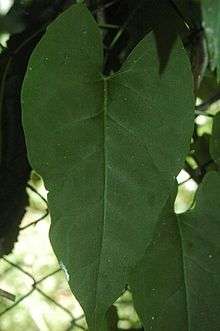Reynoutria multiflora
Reynoutria multiflora (synonyms Fallopia multiflora and Polygonum multiflorum) is a species of flowering plant in the buckwheat family Polygonaceae.[1] It is known as tuber fleeceflower[2] and Chinese knotweed. It is native to central and southern China.[3][4]
| Reynoutria multiflora | |
|---|---|
 | |
| Scientific classification | |
| Kingdom: | Plantae |
| Clade: | Tracheophytes |
| Clade: | Angiosperms |
| Clade: | Eudicots |
| Order: | Caryophyllales |
| Family: | Polygonaceae |
| Genus: | Reynoutria |
| Species: | R. multiflora |
| Binomial name | |
| Reynoutria multiflora | |
| Synonyms[1] | |
| |
Description
Reynoutria multiflora is a herbaceous perennial vine growing to 2–4 m (6 ft 7 in–13 ft 1 in) tall from a woody tuber. The leaves are 3–7 cm (1.2–2.8 in) long and 2–5 cm (0.79–1.97 in) broad, broad arrowhead-shaped, with an entire margin. The flowers are 6–7 mm (0.24–0.28 in) diameter, white or greenish-white, produced on short, dense panicles up to 10–20 cm (3.9–7.9 in) long in summer to mid autumn. The fruit is an achene 2.5–3 mm (0.098–0.118 in) long.[3]
Traditional medicine
Reynoutria multiflora is listed in the Chinese Pharmacopoeia and is one of the most popular perennial traditional Chinese medicines. It is known as he shou wu in China and East Asia.[5] Another name for the species is fo-ti.[6][7][8] Overconsumption can lead to toxicity-induced hepatitis.[9]
Chemistry
More than 100 chemical compounds have been isolated from Reynoutria multiflora, and the major components have been determined to be stilbenes, quinones, flavonoids, and others. Its extract contains a stilbene glycoside.[10] [11]
References
- "Reynoutria multiflora (Thunb.) Moldenke", Plants of the World Online, Royal Botanic Gardens, Kew, retrieved 2019-02-25
- "Polygonum multiflorum". Natural Resources Conservation Service PLANTS Database. USDA. Retrieved 12 October 2015.
- "Fallopia multiflora". Flora of China.
- "Reynoutria multiflora". Germplasm Resources Information Network (GRIN). Agricultural Research Service (ARS), United States Department of Agriculture (USDA). Retrieved 21 December 2017.
- Bounda, G. A; Feng, Y (2015). "Review of clinical studies of Polygonum multiflorum Thunb. And its isolated bioactive compounds". Pharmacognosy Research. 7 (3): 225–236. doi:10.4103/0974-8490.157957. PMC 4471648. PMID 26130933.
- "Fo-ti". WebMD.
- Lin, Longfei; Ni, Boran; Lin, Hongmei; Zhang, Miao; etc. (15 January 2015). "Traditional usages, botany, phytochemistry, pharmacology and toxicology of Polygonum multiflorum Thunb.: A review". Journal of Ethnopharmacology. 159: 158–183. doi:10.1016/j.jep.2014.11.009. PMC 7127521. PMID 25449462.
- "Polygonum multiflorum and liver reactions". MHRA. 2006. Archived from the original on 2014-12-05.
- Jung, KA; Min, HJ; Yoo, SS; Kim, HJ; Choi, SN; Ha, CY; Kim, HJ; Kim, TH; et al. (2011). "Drug-Induced Liver Injury: Twenty Five Cases of Acute Hepatitis Following Ingestion of Polygonum multiflorum Thunb". Gut and Liver. 5 (4): 493–9. doi:10.5009/gnl.2011.5.4.493. PMC 3240794. PMID 22195249.
- Tang, J (2007). "Antioxidant activity of stilbene glycoside from Polygonum multiflorum Thunb in vivo". Food Chemistry. 104 (4): 1678–1681. doi:10.1016/j.foodchem.2007.03.022.
- Grech J. N. , Li Q. , Roufogalis B.D., Duke C.C. Novel Ca2+-ATPase Inhibitors from the Dried Root Tubers of Polygonum multiflorum. J Nat Prod-Lloyda 57(12), 1682-1687, 1994.
External links
| Wikimedia Commons has media related to Reynoutria multiflora. |